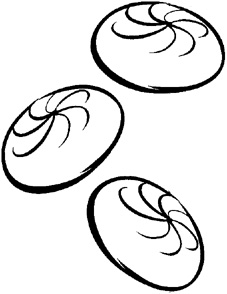
MAKES ABOUT 24 BUNS
Steamed or baked, these savory and spicy pork buns are several provinces (and maybe light-years) north of the classic Cantonese pork buns with their heavy though compelling sweetness. I adore them and think them worth the trouble.
The beauty of buns is that they can be prepared well in advance—days ahead, if you wish—and then popped into the steamer or oven to reheat at any given hungry moment.

My favorite tool for rolling out dough disks to shape them for buns is a 6-inch length cut from a broom handle. Amy uses a classier French rolling stick that is a big longer and tapered at the ends but is about the same 1 inch in diameter. Both are very easy to control. You roll with the seat of one palm while the fingers of the other hand are busy turning the dough. You can perform the same feat with a larger rolling pin, but be a bit more demure, lest the weightier pin steamroller the dough and crush the belly button.
Basic Bun Dough (page 363)
MARINADE AND PORK:
1 tablespoon hoisin sauce
2 teaspoons soy sauce
1½ teaspoons China Moon Chili-Orange Oil (page 15)
1 teaspoon “goop” from China Moon Chili-Orange Oil
2 teaspoons cornstarch
2 teaspoons Chinese rice wine or dry sherry
1 pound coarsely ground pork butt
AROMATICS:
2 tablespoons finely minced fresh ginger
2 tablespoons finely minced garlic
½ cup thinly sliced green and white scallion rings
1 small red Fresno chili, finely minced
1 small green serrano chili, finely minced
SEASONINGS:
2 tablespoons mushroom soy sauce
1 tablespoon Serrano-Lemongrass Vinegar (page 19) or unseasoned Japanese rice vinegar
1½ tablespoons cider vinegar
½ teaspoon Chinese chili sauce
4 to 5 tablespoons corn or peanut oil, for stir-frying
1 large yellow onion, finely diced
1 cup finely diced celery
2 cups diced Napa cabbage
2 tablespoons cornstarch
3 tablespoons cold pork or chicken stock or water

1. Make the bun dough as detailed in steps 1 through 3 on page 364.
2. Combine all of the marinade ingredients through the rice wine in a bowl; stir until the cornstarch is smooth. Add the pork and stir with your hand in one direction until thoroughly blended. Press a piece of plastic wrap directly on top of the meat and set aside to marinate at cool room temperature for several hours, or refrigerate overnight. Bring to room temperature before cooking.
3. Combine the aromatics through the serrano chili in a small dish; cover until ready to use.
4. Combine the seasonings in a small bowl. Stir to blend, leaving the spoon in the bowl.
5. Heat a wok or large heavy skillet over high heat until hot enough to evaporate a bead of water on contact. Add 1 tablespoon of the oil, swirl to glaze the pan, and reduce the heat to moderately high. When the oil is hot enough to sizzle a bit of pork, add the pork to the pan. Toss and poke briskly with a spatula to break up the meat, adjusting the heat so it sizzles heartily. As soon as the pork is 95 percent gray, remove it from the pan and drain it in a colander. Clean the pan and return it to the stove.
6. Heat the pan over high heat until a bead of water evaporates on contact. Add 1 tablespoon of the oil, swirl to glaze the pan, and reduce the heat to moderately high. When the oil is hot enough to sizzle a bit of onion, add the onion and toss until translucent and golden, about 4 minutes. Adjust the heat to maintain a merry sizzle and drizzle a bit more oil down the side of the pan, if needed to prevent sticking. Spread the onions on a platter, wipe the pan clean, and return it to the stove.
7. Heat the pan over high heat until a bead of water evaporates on contact. Add 2 tablespoons of the oil, swirl to glaze the pan, and reduce the heat to moderate. When the oil is hot enough to sizzle a scallion ring, add the aromatics. Stir gently until fully fragrant, 20 to 30 seconds, adjusting the heat so they foam without browning. Add the celery, toss to combine, then lower the heat and let stew until softened. Add the cabbage, toss to combine, and let stew until juicy, 5 to 6 minutes in all. Return the pork to the pan. Slide the onion along with any of its liquids into the pan as well. Toss to combine. Stir the seasonings and add them to the pan. Toss until the mixture is very hot and the liquids come to a simmer.
8. Quickly blend the cornstarch and the stock or water until smooth, then add it to the pan in a thin stream looped over the filling. Stir until the mixture is thick, heavy, and glossy, and a dab cooled briefly and then chewed leaves no floury taste on the roof of your mouth, about 5 minutes. Spread the filling in a thin layer on 2 large platters or a jelly roll pan. Refrigerate, uncovered, until thoroughly cold. Once cool, taste; add a dash more of this or that if needed. The cold filling may be sealed and refrigerated for a day or two before using.
9. Shape, cook, and serve the buns as detailed in steps 4 through 9 on pages 365 and 366.

For the best crumb and loft in the final baking, as well as the easiest handling during shaping, be sure to let the dough relax in the refrigerator for a full 12 to 15 hours—or up to 24 hours, if you like—before shaping and filling.
If you are in the grip of bun desperation, you can let the dough rise to nearly double its bulk at room temperature, which should take 1 to 2 hours if the rising spot is 70 to 80°F. But, your buns (nothing personal) may look slightly wrinkled. Never mind, an imperfect bun can still be quite appealing.

MENU SUGGESTIONS: A China Moon House Salad (page 442) would be one approach here, or a pairing of the buns with most any salad you enjoy. For heartier times, a hot and sour soup would fit my own personal bill. If you are serving the buns alone, a tangle of Sweet and Tangy Red Onion Pickle (page 47) or a hill of Orange-Pickled Carrot Coins (page 58) would accentuate their flavor perfectly.
